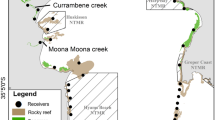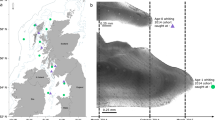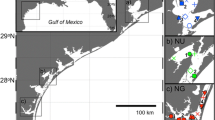Abstract
Juvenile movements are rarely considered in studies of connectivity. This study investigates movements in juvenile and adult life stages of an ecologically important temperate piscivore, the whiting (Merlangius merlangus). Adult movement was assessed from tag-recapture data collected between 1958 and 1980 around the coast of Scotland. Displacement distances ranged from 53 to 123 km. Adults rarely dispersed offshore in the North Sea, and exchange with the west of Scotland was negligible. Connectivity between nursery and spawning grounds was investigated using otolith microchemistry. Five juvenile nursery areas were discriminated with an accuracy of 75–85%. Comparing isotopic signatures of adults and juveniles indicated that several nursery areas contributed to each spawning aggregation. The lack of evidence for return migrations suggested an opportunistic and non-philopatric recruitment strategy within a single population unit. Differences in the proportion contribution of juveniles to adult aggregations also indicated that the “value” of nursery areas differed and the Scottish west coast could be viewed as a net source of recruits to the North Sea. Given the extent of juvenile dispersal, this study highlights the fact that all stages of the life cycle should be considered in studies of connectivity.








Similar content being viewed by others
References
Balls PW (1986) Composition of suspended particulate matter from Scottish coastal waters—geochemical implications for the transport of trace metal contaminants. Sci Total Environ 57:171–180
Bath GE, Thorrold SR, Jones CM, Campana SE, McLaren JW, Lam JWH (2000) Strontium and barium uptake in aragonitic otoliths of marine fish. Geochim Cosmochim Acta 64:1705–1714
Begg GA, Waldman JR (1999) An holistic approach to fish stock identification. Fish Res 43:35–44
Bolle LJ, Hunter E, Rijnsdorp AD, Pastoors MA, Metcalfe JD, Reynolds JD (2005) Do tagging experiments tell the truth? Using electronic tags to evaluate conventional tagging data. ICES J Mar Sci 62:236–246
Bowers AB (1954) Breeding and growth of whiting in Isle of Man waters. J Mar Biol Assoc UK 33:97–122
Campana SE, Chouinard GA, Hanson JM, Frechet A, Brattey J (2000) Otolith elemental fingerprints as biological tracers of fish stocks. Fish Res 46:343–357
Charlier BLA, Ginibre C, Morgan D, Nowell GM, Pearson DG, Davidson JP, Ottley CJ (2006) Methods for the microsampling and high-precision analysis of strontium and rubidium isotopes at single crystal scale for petrological and geochronological applications. Chem Geol 232:114–133
Charrier G, Coombs SH, McQuinn IH, Laroche J (2007) Genetic structure of whiting (Merlangius merlangus) in the north east Atlantic and adjacent waters. Mar Ecol Prog Ser 330:201–211
Cook RM (1997) Stock trends in six North Sea stocks as revealed by an analysis of research vessel surveys. ICES J Mar Sci 54:924–933
Cowen RK, Sponaugle S (2009) Larval dispersal and marine population connectivity. Annu Rev Mar Sci 1:443–466
Craig JK, Rice JA, Crowder LB, Nadeau DA (2007) Density-dependent growth and mortality in an estuary-dependent fish: an experimental approach with juvenile spot Leiostomus xanthurus. Mar Prog Ecol Ser 343:251–262
Dahlgren CP, Kellison GT, Adams AJ, Gillanders BM, Kendall MS, Layman CA, Ley JA, Nagelkerken I, Serafy JE (2006) Marine nurseries and effective juvenile habitats: concepts and applications. Mar Ecol Prog Ser 312:291–295
Dorval E, Jones CM, Hannigan R, van Montfrans J (2007) Relating otolith chemistry to surface water chemistry in a coastal plain estuary. Can J Fish Aquat Sci 61:411–424
Elsdon TS, Gillanders BM (2005) Alternative life-history patterns of estuarine fish: barium in otoliths elucidates freshwater residency. Can J Fish Aquat Sci 62:1143–1152
Forrester GE, Vance RR, Steele MA (2002) Simulating large-scale population dynamics using small-scale data. In: Sale PF (ed) Coral reef fishes: dynamics and diversity in a complex ecosystem. Academic Press, San Diego, pp 275–301
Galley EA, Wright PJ, Gibb FM (2006) Combined methods of otolith shape analysis improve identification of spawning areas of Atlantic cod. ICES J Mar Sci 63:1710–1717
Geffen AJ, Jarvis K, Thorpe JP, Leah RT, Nash RDM (2003) Spatial differences in the trace element concentrations of Irish Sea plaice Pleuronectes platessa and whiting Merlangius merlangus otoliths. J Sea Res 50:245–254
Gibb FM, Gibb IM, Wright PJ (2007) Isolation of Atlantic cod (Gadus morhua) nursery areas. Mar Biol 151:1185–1194
Gillanders BM (2002) Connectivity between juvenile and adult fish populations: do adults remain near their recruitment estuaries? Mar Ecol Prog Ser 240:215–223
Gillanders BM, Kingsford MJ (1996) Elements in otoliths may elucidate the contribution of estuarine recruitment to sustaining coastal reef populations of a temperate reef fish. Mar Ecol Prog Ser 141:13–20
Gordon JDM (1977) The fish populations in inshore waters of the West Coast of Scotland. The distribution, abundance and growth of the whiting (Merlangius merlangus L.). J Fish Biol 10:587–596
Gotelli N (1991) Metapopulation models: the rescue effect, the propagule rain and the core-satellite hypothesis. Am Nat 138:768–776
Grimm V, Reise K, Strasser M (2003) Marine metapopulations: a useful concept? Helgol Mar Res 56:222–228
Guy CS, Blankenship HL, Nielsen LA (1996) Tagging and marking. In: Murphy BR, Willis DW (eds) Fisheries techniques, 2nd edn. American Fisheries Society, US, pp 353–439
Halliday RG, Pinhorn AT (1990) The delimitation of fishing areas in the Northwest Atlantic. J Northw Atl Fish Sci 10:1–37
Hastings A (1993) Complex interactions between dispersal and dynamics: lessons from coupled logistic equations. Ecology 74:1362–1372
Heath M, Gallego A (1997) From the biology of the individual to the dynamics of the population: bridging the gap in fish early life stages. J Fish Biol 51(Supplement A):1–29
Hislop JRG (1975) The breeding and growth of whiting in captivity. J Cons Int Explor Mer 36:19–127
Hislop JRG (1984) A comparison of the reproductive tactics and strategies of cod, haddock, whiting and Norway pout in the North Sea. In: Potts GW, Wootton RJ (eds) Fish reproduction: strategies and tactics. Academic Press, London, pp 311–330
Hislop JRG, MacKenzie K (1976) Population studies of the whiting of the northern North Sea. J Cons Int Explor Mer 37:98–111
Huberty CJ (1994) Applied discriminant analysis. Wiley, New York, p 466
Hunt JJ (1992) Morphological characteristics of otoliths for selected fish in the Northwest Atlantic. J Northw Atl Fish Sci 13:63–75
Hutchinson WF, Carvalho GR, Rogers SI (2001) Marked genetic structuring in localised spawning populations of cod Gadus morhua in the North Sea and adjoining waters, as revealed by microsatellites. Mar Ecol Prog Ser 223:251–260
Kinlan BP, Gaines SD (2003) Propagule dispersal in marine and terrestrial environments: a community perspective. Ecology 84:2007–2020
Kritzer JP, Sale PF (2004) Metapopulation ecology in the sea: from Levins’ model to marine ecology and fisheries science. Fish Fish 5:131–140
Leakey CDB, Attril MJ, Fitzsimons MF (2009) Multi-element otolith chemistry of juvenile sole (Solea solea), whiting (Merlangius merlangus) and European seabass (Dicentrarchus labrax) in the Thames Estuary and adjacent coastal regions. J Sea Res 61:268–274
Lin S–H, Chang C-W, Iizuka Y, Tzeng W–N (2007) Salinities, not diets, affect strontium/calcium ratios in otoliths of Anguilla japonica. J Exp Mar Biol Ecol 341:254–263
Metcalfe JD (2006) Fish population structuring in the North Sea: understanding processes and mechanisms from studies of the movements of adults. J Fish Biol 69((suppl C)):48–65
Millar RB (1990a) Comparison of methods for estimating mixed stock fishery composition. Can J Fish Aquat Sci 47:2235–2241
Millar RB (1990b) A versatile computer program for mixed stock fishery composition estimation. Can Tech Rep Fish Aquat Sci 1753:1–29
Neat FC, Wright PJ, Zuur AF, Gibb IM, Gibb FM, Tulett D, Righton D, Turner RJ (2006) Residency and depth movements of a coastal group of Atlantic cod (Gadus morhua, L.). Mar Biol 148:643–654
Nielsen EE, Wright PW, Hemmer-Hansen J, Poulsen NA, Gibb IM, Meldrup DM (2009) Microgeographical population structure of cod Gadus morhua in the North Sea and west of Scotland: the role of sampling loci and individuals. Mar Ecol Prog Ser 376:213–225
Palsbøll PJ, Bérube M, Allendorf FW (2006) Identification of management units using population genetic data. Trends Ecol Evol 22:11–16
Palumbi SR (2003) Population genetics, demographic connectivity and the design of marine reserves. Ecol Appl 13:S146–S158
Palumbi SR (2004) Why mothers matter. Nature 430:621–622
Philippart CJM, Henderson PA, Johanssen T, Rijnsdorp AD, Rogers SI (1998) Latitudinal variation in fish recruits in northwest Europe. J Sea Res 39:69–77
Polunin NVC (2002) Marine protected areas, fish and fisheries. In: Hart PJB, Reynolds JC (eds) Handbook of fish and fisheries, vol 2. Blackwell, Oxford, pp 293–318
Prince J, Hilborn R (1998) Concentration profiles and invertebrate fisheries management. Can J Fish Aquat Sci 125(Special publication):187–196
Rogers SI, Ellis JR (2000) Changes in the demersal fish assemblages of British coastal waters during the 20th century. ICES J Mar Sci 57:866–881
Sale PF, Hanski I, Kritzer JP (2006) The merging of metapopulation theory and marine ecology: establishing the historical context. In: Kritzer JP, Sale PF (eds) Marine metapopulations. Academic Press, San Diego, pp 3–28
Sokal RR, Rohlf FJ (1995) Biometry: the principles and practice of statistics in biological research, 3rd edn. W H Freeman and Co., New York
Solmundsson J, Palsson J, Karlsson H (2005) Fidelity of mature Icelandic plaice (Pleuronectes platessa) to spawning and feeding grounds. ICES J Mar Sci 62:189–200
Stephenson RL (1999) Stock complexity in fisheries management: a perspective of emerging issues related to population sub-units. Fish Res 43:247–249
Temming A, Floeter J, Ehrich S (2007) Predation hot spots: large scale impact of local aggregations. Ecosystems 10:865–876
Thorrold SR, Latkoczy C, Swart PK, Jones CM (2001) Natal homing in a marine fish metapopulation. Science 291:297–299
White JW, Ruttenberg BI (2007) Discriminant function analysis in marine ecology: some oversights and their solutions. Mar Ecol Prog Ser 329:301–305
Whitehead PJP, Bauchot M-L, Hureau J-C, Nielsen J, Tortonese E (1986) Fishes of the North-eastern Atlantic and the Mediterranean. UNESCO, Paris
Windle MJS, Rose GA (2007) Do cod form spawning leks? Evidence from a Newfoundland spawning ground. Mar Biol 150:671–680
Wright PJ, Galley E, Gibb IM, Neat FC (2006a) Fidelity of adult cod to spawning grounds in Scottish waters. Fish Res 77:148–158
Wright PJ, Neat FC, Gibb FM, Gibb IM, Thordarson H (2006b) Evidence for metapopulation structuring in cod from the west of Scotland and North Sea. J Fish Biol 69(Supplement C):181–199
Wright PJ, Tobin D, Gibb FM, Gibb IM Assessing nursery contribution: relevance to closed areas in haddock (Melanogrammus aeglefinus). Mar Ecol Prog Ser (in Press)
Acknowledgments
We gratefully acknowledge the skipper and crew of FRV ‘Clupea’ along with Martha O’Sullivan and Francis Neat for help in sample collection. We thank Margaret Bell and all those involved in past tagging and to ICES for access to their online database of trawl surveys (DATRAS). Special thanks are paid to the staff at the Research and Productivity Council (RPC) in New Brunswick, Canada for the ICP-MS elemental analysis. Finally, we are grateful to Julian Augley, Francis Neat, Myron Peck and two anonymous reviewers for comments on an earlier version of the manuscript. This research was funded by the Scottish Government, project MF 0464.
Author information
Authors and Affiliations
Corresponding author
Additional information
Communicated by M. A. Peck.
Rights and permissions
About this article
Cite this article
Tobin, D., Wright, P.J., Gibb, F.M. et al. The importance of life stage to population connectivity in whiting (Merlangius merlangus) from the northern European shelf. Mar Biol 157, 1063–1073 (2010). https://doi.org/10.1007/s00227-009-1387-7
Received:
Accepted:
Published:
Issue Date:
DOI: https://doi.org/10.1007/s00227-009-1387-7




